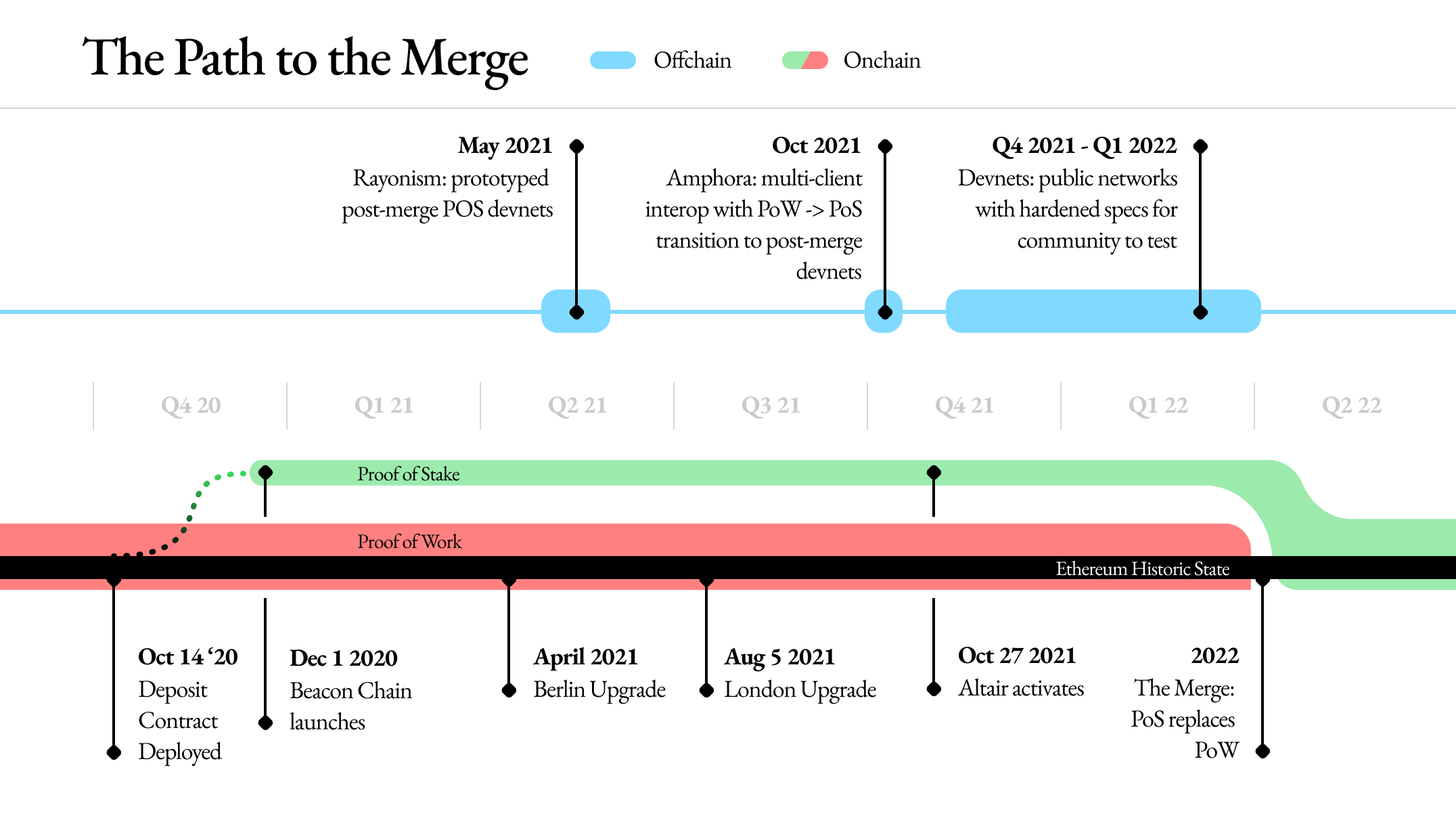
In 23 days the Ethereum network will transition to a proof-of-stake (PoS) consensus algorithm after operating as a proof-of-work (PoW) blockchain since July 30, 2015. While the change may not mean much to ethereum users and traders, what’s changing under the hood is a very big deal.
You’ve Heard About The Merge, Why Is It a Big Deal?
Next month will be a monumental time for the Ethereum network and its participants. The Merge will likely be one of the most anticipated and recognizable upgrades the blockchain has seen since The DAO hard fork. On or around September 15, 2022, Ethereum will implement The Merge and that means the chain will completely change the consensus mechanism it once used. Since the blockchain was created, Ethereum’s consensus mechanism has been a proof-of-work (PoW) scheme, similar to Bitcoin’s consensus mechanism.
However, instead of the PoW consensus mechanism SHA256, Ethereum relies on a scheme called Ethash, a PoW consensus agreement preceded by a mechanism known as Dagger-Hashimoto. The main goal of Ethash was to offer ASIC resistance but after a few years, Ethash ASIC miners appeared on the market alongside the use of graphics processing units (GPUs). Similar to Bitcoin’s PoW consensus algorithm, Ethash miners must put forth the computational cost of purchasing and operating ASIC or GPU miners, and using electricity.

When The Merge takes place, Ethereum will not depend on miners to validate transactions. Instead, the network’s transactions will be validated by entities called validators. By using a PoS consensus mechanism, Ethereum validators are selected by owning 32 ether and they are required to run three different pieces of software which include a validator, an execution client, and a consensus client. At the time of writing, 13,406,821 ETH has been added to the Ethereum 2.0 contract and there are more than 416,000 validators.
The Ethereum blockchain’s roadmap has had plans to become a PoS chain for a number of years. The Ethereum Foundation provides six different reasons why PoS is an improvement and one of the most talked about is “better energy efficiency.” The Ethereum Foundation’s summary of ETH’s transition to PoS also says that the consensus mechanism provides “lower barriers to entry” because of “reduced hardware requirements” and “there is no need for elite hardware to stand a chance of creating new blocks.”
Ethereum’s proof-of-work miners, the ones with ASICs and GPUs, will need to mine another crypto asset that leverages the Ethash algorithm and there are a few that exist today. Miners can choose from mining ethereum classic, ravencoin, ergo, beam, and possibly a new PoW Ethereum fork that is created amid The Merge transition. A few days ago, on August 20, 2022, Ethereum Classic’s hashrate reached an all-time high. Ethereum (ETH) will follow a new set of consensus rules and mining ethereum with a machine will be obsolete. While the PoS topic has been discussed a great deal, development toward reaching the goal has been successful as well.
Presently, Ethereum runs a PoS chain called the Beacon chain that runs parallel with the PoW blockchain network. Developers have safely docked The Merge with all three major testnets — Ropsten, Sepolia, and Goerli — and approximately nine shadow forks have been executed. The Merge will be executed on Ethereum’s main network on or around September 15, 2022, or when the total difficulty reaches 58750000000000000000000. At that time the network will merge with the PoS consensus mechanism that has been applied to the Beacon chain, and the testnets Ropsten, Sepolia, and Goerli.
What do you think about Ethereum changing its consensus mechanism to PoS from PoW? Let us know what you think about this subject in the comments section below.
Image Credits: Shutterstock, Pixabay, Wiki Commons
Disclaimer: This article is for informational purposes only. It is not a direct offer or solicitation of an offer to buy or sell, or a recommendation or endorsement of any products, services, or companies. Bitcoin.com does not provide investment, tax, legal, or accounting advice. Neither the company nor the author is responsible, directly or indirectly, for any damage or loss caused or alleged to be caused by or in connection with the use of or reliance on any content, goods or services mentioned in this article.






















Comments (No)